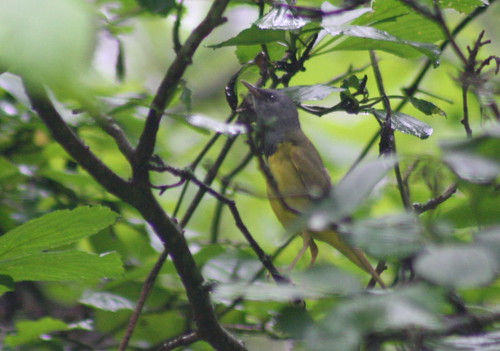Nighthawks are not even close to being hawks, but they hunt on the wing, that is, they "hawk" for insects, and are most active in twilight. My dad used to call them "bullbats." If you use the word "bull" to mean "large or strong," they certainly would be large, strong bats, if they were bats. He told me they liked to hang around the lights at the ballpark and sometimes along the street. I used to see them in those places too as a kid, but I see fewer and fewer of them now flying erratically over towns. The Sibley Guide to Bird Life and Behavior, by David Sibley (2001), notes that Common Nighthawk populations have declined throughout their breeding range (p. 352). The breeding range covers most of the Canada and the US (excluding south and central California, Alaska, and areas near or north of the arctic circle), and the western portion of Mexico (excluding Baja California). Factors contributing to the decline include the use of insecticides, and the loss of open areas that they need for hunting and mating displays (Sibley).
Nighthawks don't build nests, laying their eggs on the ground in open, rocky areas. They have adapted to using flat roofs covered with gravel, but as these become less common and roofs insulated with smooth PVC coatings become the norm, nighthawks have lost an important resource. In her book 101 Ways to Help Birds, Laura Erickson (2006) discusses ways to accommodate nighthawk nesting sites (p. 169) by providing pads with gravel in shaded areas of flat roofs.
Besides their beautiful, haphazard flight, male nighthawks have an intriguing display. I heard it "in the wild" only once. I was sitting on the front stoop of a shop, enjoying a traditional St. Louis treat, a "concrete," when I heard it. Nighthawks had been flying overheard, calling with nasal, off-key notes, "beans...beans..." when I heard a sound that shouldn't have come from a bird. Greg Budney, audio curator of the Macaulay Library at Cornell, describes it as similar to "a truck roaring by, that suddenly disappears." Somewhere along the city street, a male nighthawk dove between the buidlings, creating that roar as wind passed through the long flight feathers. Perhaps he planned his display to take advantage of the echoes in the urban "canyon."
At the end of the recording below, you hear this mechanical sound. If you have 2 minutes, check out the video from Cornell's Lab of Ornithology which I embedded below it. Thanks to Bill Bouton for his great photo of a Common Nighthawk above, taken in northern California, and to Don Jones who recorded the species in New Jersey, and the Cornell Lab, all of whom licensed their work with Creative Commons.
You might also like:
 |
| Crossley ID Guide |
 |
| Macaulay Library of Animal Sounds |
 |
| Mysterious Sounds of the Night |







